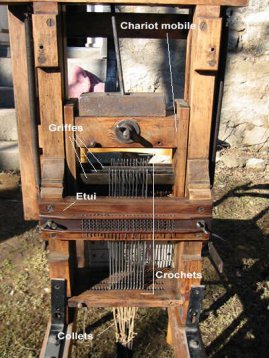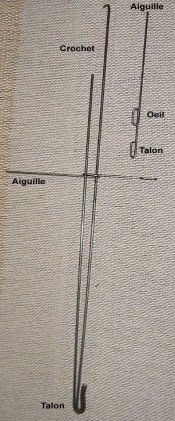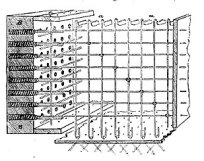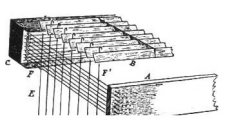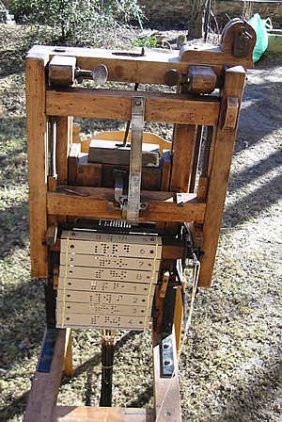- Home
- Resurrection ▾
-
Learn ▾
- Free library
- Glossary
- Documents
- Initiation
-
Shaped fabrics
- Introduction
- Popularization
- Definitions
- Le métier de façonné
- Principes du façonné
- Mécaniques de façonné
- Le jeu des crochets
- Les cartons
- Chaîne des cartons
- Mécanique 104 en détail
- Pour en finir
- Montage façonné
- Empoutage 1/3
- Empoutage 2/3
- Empoutage 3/3
- Punching, hanging and dip
- Autres façonnés
- Façonnés et Islam
-
Cours de tissage 1912
- Bâti d'un métier
- Le rouleau arrière
- Les bascules
- Formation du pas
- Position de organes
- Mécanique 104 Jacquard
- Fonctionnement 104
- Lisage des cartons
- Le battant du métier
- Le régulateur
- Réduction et régulateur
- Mise au métier d'une chaîne
- Mise en route du métier
- Navettes à soie
- Battage
- Ourdissage mécanique
- Préparation chaînes et trames
- Equipment ▾
- Chronicles ▾
- Fabrics ▾
- Techniques ▾
- Culture ▾
- Language ▾
We can easily conclude that for a warp thread to be caught (hence lifted), it is enough that its hook is hooked by the claw AND THEREFORE its needle is not pushed back. So we need to leave the needles of all the threads that are to be picked up and push the needles of all the threads that must be left (do not move) through the cartons.
This is now clearer in our minds, and we understand that it is the Jacquard cartons that will be charged with pushing the needles of the left threads and leaving the needles of the threads taken up.
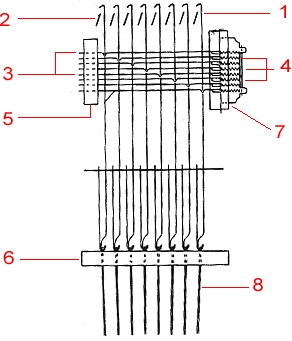
Now, let us imagine that before pulling the claws 2 upwards, we push with the finger the end of a needle 3, at its outer exit from the needle plate 5.The needle 3, under the pressure of the finger, sinks to the right by crushing its spring 4 (elastic) located at the other end.
Since the hook 1 is trapped in the eyelet situated along the length of the needle 3, it is also obliged to retreat. It then moves away from the claw 2 and will not be hooked by it as it moves upward. Thus, with the hook remaining in place, the mesh located at the bottom will not lift either the warp thread which passes through it.
We will deal later with the boxes which make it possible to make the selection of the hooks which must rise ... It is enough for us now to understand this:
If the claws 2 are lifted upwards, it can be seen on the sketch that all the hooks 1 will be hooked by these claws 2 moving upwards. The hooks 2 will therefore follow in movement and be driven upwards. The collars 8 also follow the movement since they are hooked to the base of the hooks. And at the other end of these collars 8, what do you find?The individual stitches in each of which pass a warp thread which also follows the upward movement.
Hook and needle
Here we see a needle and aHook threaded into the eye of another needle.
We have therefore reviewed the elements involved in the lifting of the threads.We shall now describe the mode of operation of these elements.
We observe the following parts, numbered in fig.3, and shown in fig.1 and fig.2:1 - Mechanical hook (EE 'in fig.1)2 - Claw (B in Fig.1)3 - Needles (FF 'in FIG. 1)4 - Elastic (inside C in fig.1)5 - Needle plate (A in fig.1)6 - Cutting board7 - Needle case (C in fig.1)8 - Arcade
Parts 3, 4, 5, 6 and 7 are fixed and do not move.Parts 2, 2, and 8 are movable and move upwardly.
Let us again observe this figure 1 in three dimensions.
The arcade board D is pierced with as many holes as there are hooks on the mechanism.A collar (loop of string) E 'is passed through each hole of the collar board and hooked to the heel of the hook, heel resting on the hole.Above, the hook itself passes through the eyelet made in the needle FF '. This needle is an iron rod with an eyelet along its length and terminated at one end (towards C) by a loop which rests against a spring (elastic) enclosed in the case C. Its other end passes through a hole in the plate Needles A.Here, for clarity, only one row of 8 hooks and 8 needles is shown.
Finally, it is observed that the hook has its upper end curved in a hook and that these hooks are at rest positioned above the movable claws B. In such a way that if the movable claws B were moved upwards they would hook the hooks And would drive them up.
This sketch always represents the same set that we must discover, in only two dimensions.
This simplified sketch represents the same set drawn otherwise.
This simplified sketch is the entire system concerned.
Here is first the picture of a smallJacquard mechanic of 104 hooks.
The movement of the hooks
We will see how the hooks of the mechanism behave, the role of which is to raise itself when it is necessary to bring about the raising of the warp yarn to which it is connected by means of a string (arch) and a mesh (Smooth).
The hand loom equipped with a Jacquard mechanism generally has only one pedal called "walking". He owns two if he uses two Jacquard mechanics, but we'll see later. Each time the single pedal is pressed (on), the mechanism is actuated before the passage of a weft. This action involves in all and for all three consecutive actions:
By pressing the pedal:
Lifting the selected brackets from the previous shot. This raising raises the threads.Presentation of the next cartonBy releasing the pedal (after passing the frame):
Descent of the raised hooks. This descent lowers the warp threads.Select the hooks for the next crop.No more no less.
Let us now see how this mechanism, with its hooks and cartons, presents itself.In order to understand the principle without encumbring details, we will use some very simplified sketches.
The movement of the hooks

